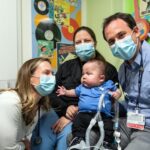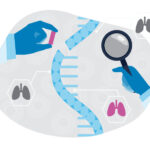New hospital discharge practices could improve health of infants with bronchopulmonary dysplasia

The chronic lung disease bronchopulmonary dysplasia (BPD) affects a significant number of infants who were born early and have underdeveloped lungs. They typically require lengthy specialized care in a neonatal intensive care unit (NICU) before they can go home with their families.
But getting home doesn’t mean health risks are behind them. Their parents are suddenly their primary health care providers, responsible for managing oxygen therapy and medications, monitoring growth and nutrition, and making follow-up appointments with specialists. It’s a difficult responsibility for families, who often lack an understanding of how to deliver a high level of medical care — and it unfortunately can affect their child’s well-being.
“Some infants can wean off such care, but up to 50 percent of infants with BPD end up being re-hospitalized,” says Jonathan Levin, MD, MBI, a neonatologist and pulmonologist in the divisions of Newborn Medicine and Pulmonary Medicine at Boston Children’s.
Levin and specialists from around the world want to reduce that number with a new set of recommended discharge practices. They will work with NICUs to implement the practices, with the aim of improving an infant’s transition in care from hospital to home.
BPD experts reach a consensus on discharge practices
In 2021, the American Thoracic Society (ATS) released recommendations on the outpatient care of infants, children, and adolescents who have respiratory disease because of premature birth. Levin says that while these guidelines were helpful for ongoing care, they didn’t focus on the transition from hospital to home, and that’s a critical time to identify which children need more extensive follow-up care and how that should be managed. The 2021 guidelines also didn’t individualize recommendations based on a child’s severity of lung disease.
“Clinicians recognize there’s going to be increased risk for respiratory problems after an infant leaves the NICU,” Levin says. “But what we don’t really have are any great strategies for them. Who do we recognize is at greatest risk? Who needs proactive follow-up with a pulmonologist to help manage these issues when they go home?”
To finally get transition practices on paper, Levin, Boston Children’s pulmonologist Lystra Hayden, MD, MMSc, and other researchers recruited neonatologists and pulmonologists from the Bronchopulmonary Dysplasia Collaborative, a consortium of more than 30 international pediatric centers with expertise in BPD treatment. They reached a consensus opinion on several major points that could shape transition care, including categories of BPD severity, follow-up care expectations depending on severity, and the education of parents on at-home care.
Takeaways for NICUs that treat infants with BPD
The group’s recommended discharge practices are included in a study published this year in The Journal of Pediatrics. Here are highlights of those recommendations:
Follow-up care
- Premature infants with BPD who remained on respiratory support at 36 weeks post-menstrual age (gestational weeks combined with chronological weeks) — what is considered moderate or severe BPD — should have a pulmonary follow-up visit within one to two months of discharge. This also includes those with poor growth, persistent tachypnea, diuretic use, or pulmonary hypertension (PH). Those with BPD who are on home oxygen should also have a follow-up in that timeline but could also be seen by a specialist within two weeks.
- Infants with moderate or severe BPD should have a routine echocardiogram after 36 weeks of postmenstrual age to screen for PH. Those on oxygen should have a baseline chest radiograph right before or soon after discharge.
- Those with mild BPD should have a neonatal follow-up with at least one pulmonary consultation one to two months after discharge, if the specialists’ resources allow, but they should receive more care if complications develop.
- Infants with BPD of any severity should have specialized neonatal developmental follow-up.
- Additional testing is recommended for certain scenarios, including infants with BPD and a history of intrauterine growth restriction, poor growth, non-oral feeds at discharge, persistent tachypnea, prolonged diuretic use, and PH.
Educating parents
Before discharge, a NICU can help families prepare for the many steps of home care. The group recommends that parents receive training in several areas, including:
- cardiopulmonary resuscitation
- preventing infectious exposures
- observing and monitoring breathing
- managing equipment and medications
- safe sleep practices
- monitoring for signs of feeding difficulties and aspiration
The study’s authors will work closely with NICUs to implement the recommendations. They also will soon survey families and health care providers to see if established discharge practices improved infants’ respiratory care.
“An infant goes from this intense period of monitoring in the hospital to being home and in their parents’ hands,” Levin says. “We want to set up families for success in these critical first few years of life.”
Learn more about the Center for Healthy Infant Lung Development.
Related Posts :
-

Optimizing care for bronchopulmonary dysplasia, infant by infant
Preterm newborns with bronchopulmonary dysplasia (BPD) can require ongoing mechanical ventilation to support their lungs. But babies with BPD aren't ...
-

Bringing Xavien home: One family’s journey with bronchopulmonary dysplasia
Xavien Velazquez is getting ready to celebrate his first birthday. It’s a milestone for every child but especially meaningful ...
-

Study seeks to identify household triggers for chronic lung disease in children
Home is where the heart is, but it’s also where air pollutants, allergens, and other irritants can make breathing ...
-

Cell therapy for lung disease? Proof-of-concept study shows promise
Many serious pulmonary diseases, including genetic lung diseases, lack an effective treatment other than the most extreme: lung transplant. A ...





